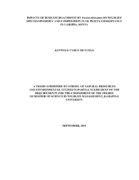Impacts of Bush Encroachment By Euclea divinorum on Wildlife Species Diversity and Composition in Ol Pejeta Conservancy in Laikipia, Kenya
Abstract
Savannah landscapes are extensively social-economically important ecosystems which support livelihoods. Despite their importance, they are facing a biome shift due to natural and anthropogenic induced perturbations leading to increase in woody species, a phenomenon referred to as bush encroachment. In Ol Pejeta Conservancy (OPC), Euclea divinorum, unpalatable woody species has become a concern due to its invasion into other habitat types which can potentially affect resources for various feeding guilds, consequently affecting ecosystem services. This study examined vegetation cover changes from 1987 to 2016, topographic features attributable to these cover changes, differences in species diversity and composition in encroached and non-encroached habitats as well as habitat preference or avoidance by various feeding guilds in the conservancy. Landsat images acquired during dry seasons were processed and classified into various vegetation cover types. Infra-red motion triggered camera traps were deployed in 2km by 2km grids for 14 days and nights in June 2016 to examine species diversity, composition and habitat preference or avoidance by various feedings guilds in OPC. Results revealed that E. divinorum cover increased upward significantly from 1987-2016 (Mann Kendall test for trend analysis tau 1, n=6, p<0.01). Further, digital elevation models, contours and slope based normalized difference vegetation index had influence on encroachment patterns by E. divinorum. Shannon Weiner diversity revealed that species diversity and richness was higher in E. divinorum and lowest in Open grassland dominated areas while Hierarchical Cluster Analysis revealed that percentage similarity in species composition was highest between E. divinorum and mixed bushland habitats. Jacobs’ Index means revealed that E. divinorum habitat was significantly avoided by all feeding guilds (t1=2.253, d.f=3, p<0.01) while A. drepanolobium dominated habitats were significantly preferred (t1=2.353, d.f= 3, p=0.03). The findings show that increase in E. divinorum cover, which has higher species diversity and evenness, however is avoided by all feeding guilds in OPC. As such, there is need to actively manage encroaching species as well as further research on impacts of encroachment on grass biomass and diversity. These findings are beneficial to policy makers regarding management of healthy ecosystems.
